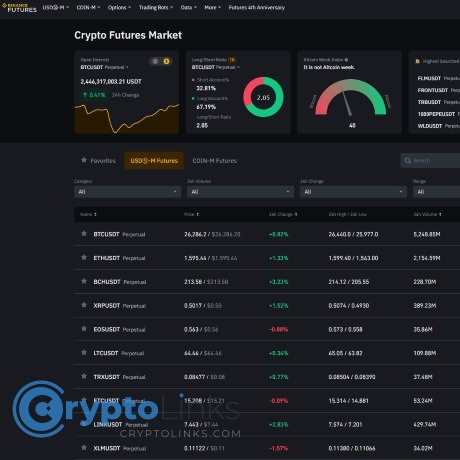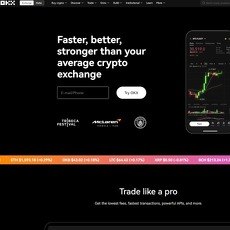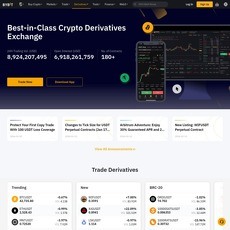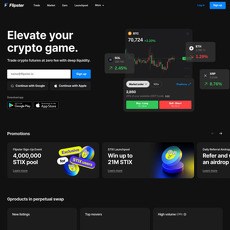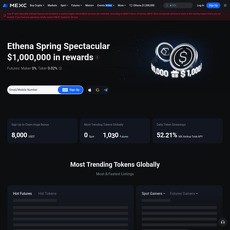Binance Futures Review
Binance Futures
binance.com
Binance Crypto Derivatives Review: A Comprehensive Guide (2025)
As a crypto enthusiast and trader, I've always been on the lookout for the best platforms to enhance my crypto journey. Among the multitude of options available, one name has consistently stood out - Binance Futures. In this comprehensive review, I'll dive deep into the world of Binance Crypto Derivatives, exploring its pros and cons, trading features, supported cryptocurrencies, fees, customer support, and security measures. By the end of this article, you'll have a clear understanding of why Binance Futures continues to lead the pack in the realm of cryptocurrency derivatives trading.
Binance Futures: The Crypto Trading Powerhouse
Pros
1. Binance-branded product: Binance Futures is an integral part of the Binance ecosystem, offering a seamless transition for users already familiar with the spot exchange.
2. High trading volume and liquidity: With massive trading volumes, Binance Futures provides traders with ample liquidity, ensuring smooth trading experiences even during volatile market conditions.
3. Industry-Leading Security (SAFU insurance fund): Binance prioritizes security, and its SAFU (Secure Assets Fund for Users) insurance fund is a testament to its commitment to safeguarding user funds.
Cons
1. Limited trading currency: Currently, Binance Futures only supports trading with USDT (Tether), which may not be suitable for users who prefer other stablecoins or cryptocurrencies.
2. Dependency on Tether (USDT): Binance Futures relies on USDT, a controversial stablecoin with its fair share of controversies.
The Rise of Binance Futures
Binance introduced its derivatives platform, Binance Futures, in September 2019. This move proved to be a game-changer, propelling Binance into a period of massive growth. The platform quickly gained traction, with daily Bitcoin futures trading volumes surpassing those of the spot BTC/USDT trading pair on the primary Binance exchange. This success demonstrated the growing demand for derivatives products in the crypto market.
Despite the emergence of numerous competitors since 2019, Binance Futures maintains its dominance as the leading derivatives platform. Over the years, it has continuously expanded its offerings, adding new cryptocurrencies, features, and tools, cementing its position as the go-to platform for crypto derivatives trading.
Why Choose Binance Futures?
Trading Bitcoin futures on Binance Futures offers a host of advantages:
1. Unparalleled liquidity: Binance Futures stands out as the most liquid platform in the crypto derivatives industry, making it the preferred choice for traders seeking high liquidity.
2. Shorting opportunities: Binance Futures allows users to short Bitcoin and other cryptocurrencies, providing a valuable hedge against market downturns and enhancing risk management.
3. Reduced capital requirements: Leverage of up to 125x is available for Bitcoin futures on Binance, enabling traders to control larger positions with less capital. However, it's essential to exercise caution when using high leverage, as it comes with increased risk.
Exploring Binance Bitcoin Futures
What Are Bitcoin Futures?
Bitcoin futures contracts on Binance allow traders to buy or sell Bitcoin at a predetermined price at a specified future date. The buyer of the contract is obligated to purchase the asset when the contract expires, while the seller is obligated to deliver it.
In addition to traditional futures contracts, Binance also offers perpetual futures contracts. These contracts differ significantly from traditional futures, as they lack preset expiry and settlement dates. Perpetual contracts are anchored to the spot index price, allowing traders to close them at any time without the constraints of expiration dates.
Bitcoin futures on Binance are denominated in USDT, although they can be settled and collateralized with USDT, BUSD, and other cryptocurrencies through the COIN-M variation. Binance Futures has also introduced quarterly futures contracts for the BTC/USD and ETH/USD trading pairs, catering to a diverse range of traders.
Getting Started with Binance Futures
To begin trading on Binance Futures, you must first create an account on the Binance platform. While the process is straightforward, it does require identity verification to comply with Binance's Know Your Customer (KYC) requirements.
Once your funds are deposited, you'll need to transfer them to your futures trading wallet. Binance offers the option to trade futures denominated in stablecoins or cryptocurrencies, providing flexibility to users. For this guide, we'll focus on USD(S)-denominated futures settled in Tether (USDT).
Leveraged Trading on Binance Futures
Binance allows traders to leverage their positions with up to 125x leverage on select pairs, such as BTC/USDT. Setting your leverage is a simple process, and it's crucial to exercise caution when using high leverage, as it significantly increases the risk of capital loss.
You can choose between two margin modes:
1. Isolated margin: This mode restricts the margin for each trade to the allocated amount. If the margin ratio reaches 100%, the position is liquidated, but it doesn't affect the rest of your account.
2. Cross margin: In this mode, all cross positions share the same asset cross-margin balance. If one position faces liquidation, it may impact your entire futures account, including the margin allocated to other positions.
For this guide, we'll use the isolated margin mode.
How to Trade Bitcoin Futures on Binance
Trading Bitcoin futures on Binance is user-friendly, offering a straightforward interface. Traders can place various types of orders, including limit orders, market orders, stop-limit/market orders, and trailing stop orders.
Opening a Short or Long Position
Limit Orders: These are used when you want to buy or sell Bitcoin at a specific price. You'll need to specify the price and the position size. Binance allows you to use a percentage of your maximum position size, making it convenient for traders. However, remember that leverage increases both potential profits and losses, so trade responsibly.
Market Orders: Market orders are the simplest type, allowing you to buy Bitcoin at the current market price. Specify the order quantity, and your position will be executed instantly at the prevailing market rate.
Stop-Limit Orders: These orders serve as stop-loss or take-profit mechanisms. You set a stop price, at which a limit order will be placed. For instance, if you bought Bitcoin at $28,000 and want to protect your trade, you can set a stop price at $27,000 with an execution price of $26,500. If the market reaches $26,500, your order will be filled.
Trailing Stop Orders: This advanced order type helps you lock in profits or limit losses as the market fluctuates. It allows you to place a pre-set order at a specific percentage away from the market price.
Closing a Position
Once you have an open position, you can monitor its status, including your entry price, margin, and liquidation price. Closing a position can be done in two ways:
Market Close: This option closes your position instantly at the best available market price.
Limit Close: A limit close lets you specify the price at which you want to close the position. This provides more control over your exit price.
Supported Cryptocurrencies on Binance Futures
Binance Futures offers an extensive selection of trading pairs, providing users with various options for leverage trading. Some of the supported cryptocurrencies include:
- Bitcoin (BTC) / USDT
- Ethereum (ETH) / USDT
- Ripple (XRP) / USDT
- Binance Coin (BNB) / USDT
- Bitcoin Cash (BCH) / USDT
- Cardano (ADA) / USDT
- Stellar (XLM) / USDT
- Tron (TRX) / USDT
- ApeCoin (APE) / USDT
- Dogecoin (DOGE) / USDT
- Polkadot (DOT) / USDT
Binance continually adds new trading pairs to meet the evolving demands of the crypto market. Notable additions include SOL, AVAX, KSM, OCEAN, HNT, SUSHI, UNI, SRM, FTM, ENJ, TOMO, NEAR, COMP, OMG, VET, ONT, ATOM, THETA, NEO, and many more.
Binance Futures Trading Fees
Trading fees are a critical consideration for active traders, as they can significantly impact profitability. Binance offers a transparent fee structure, with different fee levels based on factors such as trading volume and Binance Coin (BNB) holdings.
The default fee level for regular users is a 0.02% maker fee and a 0.04% taker fee. Makers are traders who place orders at limit prices, while takers execute market orders.
To enjoy reduced fees, traders can hold Binance Coin (BNB) and achieve a certain level of turnover volume in BTC. Binance often provides promotions and discounts for new users, making it even more attractive for traders looking to reduce their trading costs.
Binance Futures' Customer Support
Binance takes customer support seriously, offering a team of experienced support staff available to assist users globally. Whether you're a novice trader or an experienced crypto enthusiast, you can rely on Binance's responsive customer support to address your inquiries and concerns.
Security Measures of Binance Futures
Security is paramount in the world of cryptocurrency, and Binance has a strong track record in this regard. The exchange has implemented robust security measures to protect user funds, including the Secure Assets Fund for Users (SAFU) insurance fund.
In the event of a security breach, Binance's SAFU fund provides an additional layer of protection for users. The fund is funded by allocating 10% of all trading fees to ensure the security and integrity of users' assets. These funds are stored in separate cold wallets, enhancing their security.
Furthermore, Binance enforces a stringent KYC process for users of its futures exchange platform, adding an extra layer of identity verification and security.
Conclusion
In the ever-evolving world of cryptocurrency trading, Binance Futures shines as a leading platform for crypto derivatives trading. Its user-friendly interface, unparalleled liquidity, and diverse range of supported cryptocurrencies make it an ideal choice for both novice and experienced traders.
While it may have limitations, such as reliance on Tether (USDT) and limited trading currency options, Binance Futures makes up for these shortcomings with its robust security measures, responsive customer support, and competitive fee structure.
As a crypto enthusiast, I've found Binance Futures to be a valuable addition to my trading toolkit. However, it's crucial to approach leveraged trading with caution, especially if you're a beginner. Always conduct thorough research and risk management before engaging in leveraged trading on any platform.
In conclusion, Binance Futures continues to be a trailblazer in the crypto derivatives space, offering a comprehensive and secure trading experience for cryptocurrency enthusiasts worldwide. Whether you're looking to hedge your crypto portfolio or explore leveraged trading, Binance Futures remains a top choice in 2023. Happy trading!

